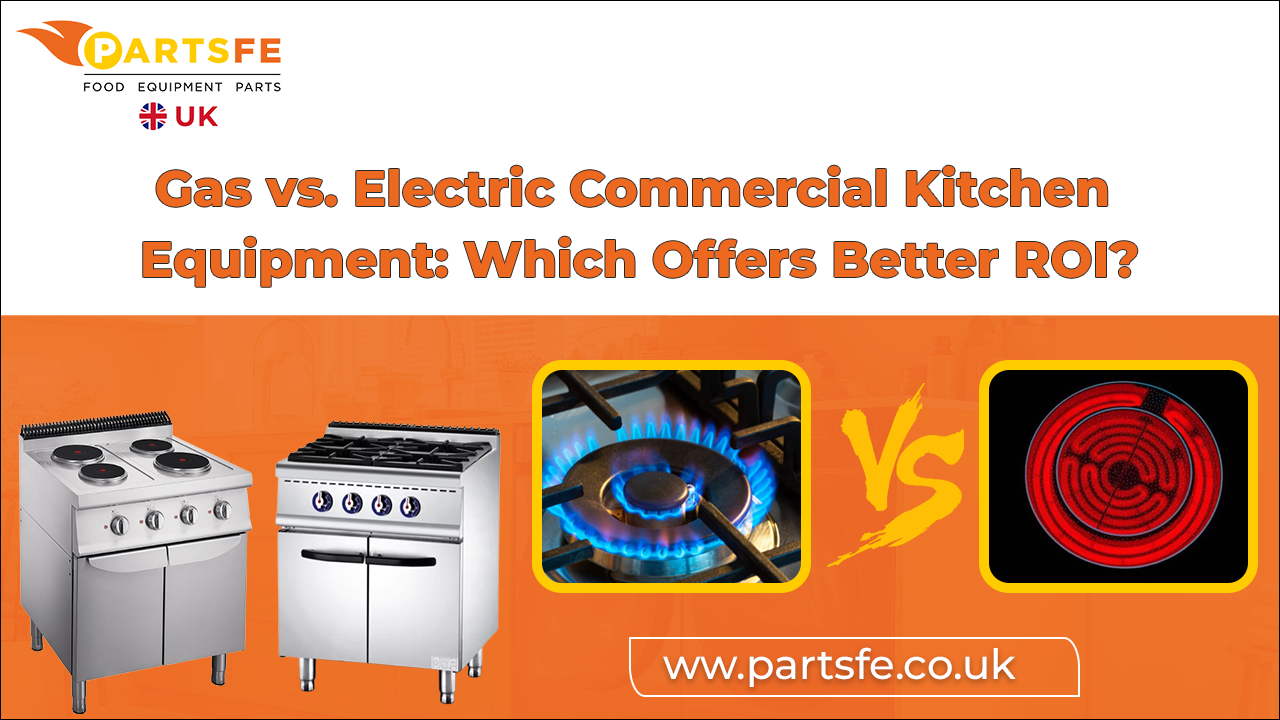Gas vs. Electric Commercial Kitchen Equipment: Which Offers Better ROI?
Commercial kitchen efficiency and profit rely heavily on the selection of kitchen equipment. The equipment you select has an impact on the quality of food served in your restaurant as well as the restaurant’s operational dynamics. The culinary world marches on, and shows no sign of slowing down, forcing a greater decision in this question of gas vs. electric kitchen equipment than ever before for restaurateurs, chefs, and kitchen managers. This guide will explore the many factors that contribute to the ROI of gas versus electric commercial kitchen equipment, from initial cost to efficiency, energy consumption, environmental impact, and safety, to maintenance.
Initial Investment Costs
The initial investment is one of the main factors in choosing commercial kitchen equipment.
-
Gas equipment comes with a higher upfront price. This is mainly because of the complexity of installation. For instance, gas appliances require gas lines and connections to supply a steady fuel and for discharging combustion gases into the atmosphere to protect staff and equipment. The early investment costs are driven up due to the requirement to hire specialized technicians. In some instances, gas lines may need to be renovated, which will cause these costs to increase even further.
-
Electric kitchen equipment has lower initial costs. Installing electric appliances is simpler and may involve Simple plug-and-play setups without extensive modifications to the kitchen infrastructure. Faster installations can result in less downtime and earlier start of operations which in turn can improve the ROI of the investment.
Operational Efficiency and Performance
Choosing between gas and electric kitchen equipment significantly impacts operational efficiency and performance.
Gas equipment: Gas appliances are known for their ability to control temperature precisely and to change heat quickly. Chefs often prefer gas for:
-
Quick changes in heat are required such as when sautéing, stir-frying, etc.
-
It can produce instant heat upon ignition, which means it can be adjusted in real-time.
-
Gas appliances, for the most part, can be extremely responsive and make a huge difference in commercial kitchens that demand fast responses to varying throughput.
Electric equipment
Electric equipment is very good at producing even and consistent heating and is therefore very good for baking and cooking jobs that need to be done at steady controlled temperatures. Electric ovens, for example:
-
They even provide heating to bake similar products like pastries and breads.
-
Some chefs may complain about the slower initial cooking time of electric devices, but in exchange, they often put less variation in both the high and the low ends of the consistency spectrum than their brothers working with gas.
Gas Interlock Systems The Ultimate Safety for Busy Commercial Kitchens
Energy Consumption and Utility Costs
Energy consumption is a critical factor in commercial kitchens, directly impacting utility costs and overall operational expenses.
-
Gas equipment: Gas is the obvious choice when evaluating the ongoing operational costs. Where natural gas is cheaper than electricity, the main advantage of gas equipment is lower energy costs. In terms of heating efficiency, restaurants may save a lot of money over time in utility expenses, and gas can provide more thrust for the money spent.
-
Electric equipment: Electric equipment is much more efficient and electricity costs can be higher. Almost all energy coming into electric appliances is directly converted to heat, In some cases, it is more energy efficient overall than gas equipment, particularly in business practices like peak usage times or demand charges.
Environmental Impact: Gas vs. Electric Kitchen Equipment
Choosing between gas and electric kitchen equipment significantly affects a restaurant's environmental footprint.
|
Environmental Impact |
Details |
|
Gas equipment |
Generates combustion gases that contribute to greenhouse gases. Restaurants may face public relations challenges and regulatory concerns when using gas cooking equipment. |
|
Electric equipment |
Offers significantly lower carbon footprints, especially when powered by renewable energy sources. Investing in electric equipment can enhance a restaurant's sustainability profile and provide a competitive edge. |
Safety Considerations and Risk Factors
When choosing between gas and electric kitchen equipment, understanding safety concerns is crucial.
-
Gas appliances work well, they but are inherently risky. Open flames are fire hazards and require safe ventilation systems to disperse heat and gases are highly robust. safety checks to make sure the equipment works correctly and safely regularly and training the staff in safely operating the gas appliances carries another layer that can be associated with the ongoing operational concern.
-
Electric equipment has fewer safety risks than open flames. Reducing heat-related discomfort for staff in a cooler kitchen environment. electric appliances have features like automatic shut-off functions which reduce the chance of accidents. But, electrical shock and equipment failure can still take place and must be checked and maintained on a routine basis.
Selecting Gas and Electric Commercial Kitchen Equipment
Commercial kitchen equipment has to be chosen wisely in terms of performance as well as cost efficiency. When you make your choice in this regard, be aware of the following factors:
Check your capacity
-
Determine what power sources are available in your kitchen.
-
It is often easier and more cost-effective to go with the existing setup if gas lines or electrical outlets are already in place.
-
Installing any new gas line can be costly, but it may pay off in the long run.
Consider the costs
-
Gas lines are costly to put in place but can cut energy costs in the long haul.
-
Electricity is more expensive, but it is more energy efficient because all incoming energy is converted directly to heat. Gas ranges may add to indoor air pollution.
Purchase for performance
-
For speed and precision, gas ranges are unmatched; cooks can change it quicker and the changes occur more evenly.
-
High-end kitchens favor electric induction cooktops, as they give good heating-up times, and keep constant temperatures.
Maintenance Needs and Long-Term Durability
When evaluating commercial kitchen equipment, understanding maintenance requirements and long-term durability is crucial.
-
Gas equipment: Gas appliances are thought to require specialized maintenance. Many service technicians are familiar with both gas and electric systems. Some operators may perceive that it’s more complicated, but performance issues and unsafe conditions are other potential reasons.
-
Electric Equipment: The lack of combustion components and the typical design of electric systems means that electric equipment tends to be simpler to maintain and repair. these appliances may have higher long-term operational costs because of Potential electrical failures and the need for battery replacements in certain models.
How to Set Up a Functional Commercial Kitchen: Key Appliances
The better option between gas and electric kitchen equipment depends on the individual needs of a commercial kitchen. Energy costs and long-term ROI vary by local energy prices and variable expenses between gas and electric. The best decisions for profitability and efficiency will be made by taking a holistic approach to this analysis. PartsFe UK offers high-quality commercial catering spare parts, fryer parts, griddle and grill parts, and oven parts from various manufacturers.
FAQs
What are the maintenance differences between gas and electric kitchen equipment?
Gas equipment may require more specialized maintenance due to combustion mechanics, while electric equipment generally has simpler maintenance requirements but may lead to higher long-term costs due to electrical repairs.
How does the choice between gas and electric affect kitchen design?
Choosing gas appliances often requires additional infrastructure for gas lines and ventilation, while electric appliances allow for easier, less invasive installations, impacting kitchen layout and design decisions.














